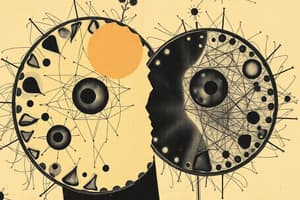Podcast
Questions and Answers
During which phase of mitosis do the chromosomes condense and become more compact?
During which phase of mitosis do the chromosomes condense and become more compact?
- Prophase (correct)
- Anaphase
- Telophase
- Metaphase
What is the primary function of cohesin and condensin proteins during prophase?
What is the primary function of cohesin and condensin proteins during prophase?
- Breaking down the nuclear membrane
- Aligning chromosomes along the cell equator
- Forming rings that hold sister chromatids together and coiling chromosomes (correct)
- Attaching chromosomes to the spindle microtubules
What event marks the transition from prometaphase to metaphase?
What event marks the transition from prometaphase to metaphase?
- The nuclear membrane breaks down
- The chromosomes condense
- The sister chromatids separate
- The chromosomes align along the cell equator (correct)
Which of the following is responsible for breaking down the nuclear membrane during prometaphase?
Which of the following is responsible for breaking down the nuclear membrane during prometaphase?
During which phase of mitosis are the chromosomes attached to the spindle via their kinetochores?
During which phase of mitosis are the chromosomes attached to the spindle via their kinetochores?
What is the primary function of the mitotic spindle during cell division?
What is the primary function of the mitotic spindle during cell division?
Which stage of mitosis involves the separation of sister chromatids and their movement towards opposite poles?
Which stage of mitosis involves the separation of sister chromatids and their movement towards opposite poles?
What is the primary role of the mitotic spindle during cell division?
What is the primary role of the mitotic spindle during cell division?
Which of the following is responsible for controlling the progression through the cell cycle?
Which of the following is responsible for controlling the progression through the cell cycle?
During which stage of mitosis do the nuclear membranes and nucleoli reappear?
During which stage of mitosis do the nuclear membranes and nucleoli reappear?
What is the primary function of checkpoints during mitosis?
What is the primary function of checkpoints during mitosis?
During which phase of the cell cycle does the majority of cell growth occur?
During which phase of the cell cycle does the majority of cell growth occur?
Study Notes
Mitosis
Overview
Mitosis is a type of cell division in which one cell (the mother) divides to produce two new cells (the daughters) that are genetically identical to itself. In the context of the cell cycle, mitosis is the part of the division process in which the DNA of the cell's nucleus is split into two equal sets of chromosomes, ensuring that each daughter cell gets a perfect, full set of chromosomes.
Phases of Mitosis
Mitosis consists of four main phases: prophase, metaphase, anaphase, and telophase.
Prophase
During prophase, the parent cell chromosomes condense and become thousands of times more compact than they were during interphase. This allows for easier manipulation and alignment during cell division. Cohesin and condensin proteins play a crucial role in this process, forming rings that hold the sister chromatids together and coiling the chromosomes into highly compact forms.
Prometaphase
In prometaphase, phosphorylation of nuclear lamins by M-CDK causes the nuclear membrane to break down into numerous small vesicles. This allows direct access for the spindle microtubules to the genetic material of the cell. As prometaphase ends and metaphase begins, the chromosomes align along the cell equator.
Metaphase
During metaphase, the chromosomes are attached to the spindle via their kinetochores, and they move to balance points called kinetochores on either side of the cell's centerline. The tension within the cell becomes balanced, ensuring that the chromosomes no longer move back and forth.
Anaphase
Anaphase is divided into two stages: anaphase A and anaphase B. In anaphase A, each chromosome's sister chromatids separate and move to opposite poles of the cell due to enzymatic breakdown of cohesin. In anaphase B, the astral microtubules anchored to the cell exert additional pull on the chromosomes, leading to their movement to opposite poles.
Telophase
Telophase marks the end of mitosis as the cell splits in half. The new nuclei begin to decondense, and nuclear membranes and nucleoli reappear. Cytokinesis starts at this stage, with cytokinesis occurring before or shortly after telophase depending on the cell type.
Mitotic Spindle
The mitotic spindle plays a critical role in organizing and separating the duplicated DNA during cell division. It consists of microtubules extending from structures called centrosomes located at opposite ends (poles) of the cell. The spindle tubules attach to the chromosomes and then shorten and move toward the poles, pulling one copy of each chromosome with them to opposite poles of the cell.
Regulation of Mitosis
Mitosis is regulated by various factors, including cyclin-dependent kinases (CDKs), which control the progression through the cell cycle, and checkpoints that ensure proper chromosomal alignment and separation before anaphase. Additionally, cell growth occurs primarily during interphase, where the cell grows by producing various proteins and cytoplasmic organelles.
Studying That Suits You
Use AI to generate personalized quizzes and flashcards to suit your learning preferences.
Description
Test your knowledge of the phases of mitosis, including prophase, metaphase, anaphase, and telophase, as well as the role of the mitotic spindle in cell division. Explore how mitosis is regulated by factors like cyclin-dependent kinases and checkpoints to ensure proper chromosomal alignment and separation.



